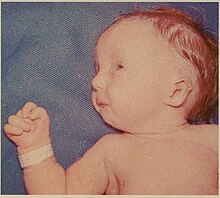
Back متلازمة إدوارد Arabic Edvards sindromu Azerbaijani Синдром на Едуардс Bulgarian Edwardsov sindrom BS Síndrome d'Edwards Catalan کۆنیشانەکانی ئێدوارد CKB Edwardsův syndrom Czech Syndrom Edwards Welsh Edwards syndrom Danish Edwards-Syndrom German
| Trisomy 18 | |
|---|---|
| Other names | Trisomy 18 (T18[1]), chromosome 18 duplication,[2] trisomy E syndrome[3], Edwards syndrome |
 | |
| Infant with trisomy 18 | |
| Specialty | Medical genetics, pediatrics |
| Symptoms | Small head, small jaw, clenched fists with overlapping fingers, profound intellectual disability[3] |
| Complications | Heart defects[3] |
| Usual onset | Present at birth[3] |
| Causes | Third copy of chromosome 18 (usually new mutation)[3] |
| Risk factors | Older mother[3] |
| Diagnostic method | Ultrasound, amniocentesis[2] |
| Treatment | Supportive care[2] |
| Prognosis | 5–10% survive past a year old[3] |
| Frequency | 1 per 5,000 births[3] |
Trisomy 18, also known as Edwards syndrome, is a genetic disorder caused by the presence of a third copy of all or part of chromosome 18.[3] Many parts of the body are affected.[3] Babies are often born small and have heart defects.[3] Other features include a small head, small jaw, clenched fists with overlapping fingers, and severe intellectual disability.
Most cases of trisomy 18 occur due to problems during the formation of the reproductive cells or during early development.[3] The chance of this condition occurring increases with the mother's age.[3] Rarely, cases may be inherited.[3] Occasionally, not all cells have the extra chromosome, known as mosaic trisomy, and symptoms in these cases may be less severe.[3] An ultrasound during pregnancy can increase suspicion for the condition, which can be confirmed by amniocentesis.[2]
Treatment is supportive.[2] After having one child with the condition, the risk of having a second is typically around one percent.[2] It is the second-most common condition due to a third chromosome at birth, after Down syndrome for a third chromosome 21.[4]
Trisomy 18 occurs in around 1 in 5,000 live births.[3] Many of those affected die before birth.[3] Some studies suggest that more babies that survive to birth are female.[2] Survival beyond a year of life is around 5–10%.[3] It is named after the English geneticist John Hilton Edwards, who first described the syndrome in 1960.[5]
- ^ "Edwards' syndrome (T18): Information for parents". December 2020.
- ^ a b c d e f g "Trisomy 18". Orphanet. May 2008. Archived from the original on 3 October 2016. Retrieved 1 October 2016.
- ^ a b c d e f g h i j k l m n o p q r "trisomy 18". GHR. March 2012. Archived from the original on 2 October 2016. Retrieved 1 October 2016.
- ^ Jorde, Lynn B.; Carey, John C.; Bamshad, Michael J. (2009). Medical Genetics (4 ed.). Elsevier Health Sciences. p. 109. ISBN 978-0323075763. Archived from the original on 2016-10-02.
- ^ "Edwards syndrome (John Hilton Edwards)". WhoNamedIt.com. Archived from the original on 2008-07-09. Retrieved 2008-07-24.